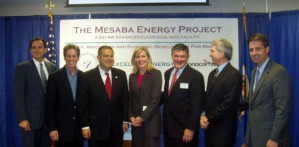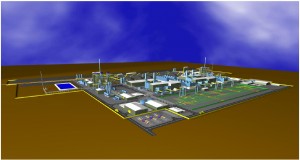Let Mesaba go…
December 19th, 2009
Jorgensen’s got to get over it — Mesaba is done, ain’t happening, dead, dead dead, yet she’s spinning those tales and hype about Excelsior Energy’s Mesaba IGCC Project. From the first words in the title, it’s lies, lies and more lies, oh, and misrepresentations and falsehoods and exaggerations and utter bullshit too! Why does the St. Paul Pioneer Press give her space forthis advertising of the nonsensical kind?
Here’s what Citizens Against the Mesaba Projet’s Charlotte Neigh had to say about it:
Julie Jorgensen is using the opportune hook of the Copenhagen conference to repeat Excelsior Energy’s same old, self-serving promotional claims about the “clean coal” technology of its Mesaba Energy Project. One must wonder why the Press unquestioningly allots opinion space to the promoter of a precarious for-profit venture, financed almost exclusively by $40 million in public funds, which have been benefiting the author and her co-founder husband, Tom Micheletti.
What Jorgensen didn’t say:
• The U.N. negotiators in Copenhagen decided to leave carbon capture and storage, the prime objective of the IGCC technology touted by Excelsior Energy, off the list of clean-energy projects eligible for the Clean Development Mechanism; the 12/17/09 Wall Street Journal reported that “clean coal seems to be getting the cold shoulder at the climate summit”, and “. . . clean coal is anything but viable right now”.
• Mesaba’s Unit I would emit 5 million tons of carbon dioxide per year and the Department of Energy has acknowledged that capturing and sequestering the CO2 from the proposed Taconite plant is not feasible.
• The claimed economic benefit has been rejected by the Minnesota Public Utilities Commission, which found the project too expensive and risky and not in the public interest.
• The need for this Project has never been proven; no utility is willing to buy its output; Xcel Energy successfully resisted efforts to force it into a power purchase agreement; and the MPUC has declined to require other utilities in the state to include Mesaba’s output in their resource plans.
• The environmental claims are yet to be adjudicated as the MPUC considers the route and siting permits and other government agencies pursue their concerns related to air, water and waste permits.
Is Jorgensen’s piece really that bad? See for yourself:
Julie Jorgensen: We need baseload power. Coal’s plentiful. Let’s clean it up
By Julie Jorgensen
Updated: 12/17/2009 05:54:25 PM CSTI’m the co-founder of Excelsior Energy, which is developing the Mesaba Energy Project, an IGCC power plant near the town of Taconite on Minnesota’s Iron Range. From my point of view, IGCC offers economic and environmental benefits to Minnesota. The Midwest is poised be a leader in the delivery of this technology. Gov. Tim Pawlenty and the Minnesota Legislature have supported the development of Minnesota’s IGCC plant, the Mesaba Energy Project, since 2003, and the project has been exempted from a statewide prohibition against new coal plants. Eleven Midwest governors established a collective goal to spur construction of at least five commercial-scale IGCC plants by 2015, and President Obama announced a goal to build five such “first-of-a-kind” clean coal plants. The U.S. Department of Energy (DOE) has provided significant funding and incentives to the Mesaba Project to offset the costs of needed innovation.
Adoption of IGCC technology is essential to cleaning up coal and mitigating climate change.
As fears mount about global warming, environmental advocates like the Clean Air Task Force and the Natural Resources Defense Council support the timely and widespread commercialization of IGCC technology. From a global perspective, the importance of commercializing a cleaner way to use coal cannot be understated: both India and China have vast coal reserves, which they will inevitably use in the cheapest and easiest possible ways to fuel their growing economies.
Additionally, the costs of new nuclear facilities may put them out of reach.
Julie Jorgensen is the former CEO of CogenAmerica, a publicly traded independent power company, and a former executive of NRG Energy, a global energy development company. She’s a co-founder of Excelsior Energy Inc., which is developing a coal gasification plant near Taconite on Minnesota’s Iron Range. Her e-mail address is JulieJorgensen@ExcelsiorEnergy.com.
Mesaba EIS? And close encounters of the Mesaba kind!
November 17th, 2009
The joint DOE and MN Dept. of Commerce EIS for Excelsior Energy’s Mesaba Project has been released. WTF? This is SUCH a waste of time. And I am at a lost to explain how it is that this even was released, why we have to bother with it, when it’s the vampire-vaporware project from hell that is dead but … but…
Excelsior Energy Mesaba Project Environmental Impact Statement
Comments on the “adequacy of the Final EIS or its impact upon the issues” are due on December 2, 2009. Send Comments to:
steve.mihalchick [at] oah.state.mn.us
or by mail to:
Steve Mihalchick, ALJ
Office of Administrative Hearings
P.O. Box 64620
St. Paul, MN 55164-0620
Here’s the Order establishing that deadline:
Is this weird language or what:
b. Such comments on the “adequacy” of the Final EIS or its “impact” upon the issues in this matter shall be filed with the Administrative Law Judge within ten business days after filing of the Final EIS.
So get cracking on “such comments” and send them in!
And just in, breaking news…
Just last Friday, a MCGPer and his son were out deer hunting on the preferred Excelsior site, guns in hand, on the alert, and what should come bursting through the trees but… BOB EVANS! Bob Evans and two other Excelsior boys, they were out viewing the site during deer hunting! That just doesn’t seem to bright.
Give it up!!! Get a job, Bob!!!
And have they forgotten that other encounter in the woods, almost exactly three years ago?
Meanwhile … the sun is coming up over New York right now…
Mesaba EIS delayed again
October 27th, 2009
For a project that’s dead, they continue to take vital signs… go figure…
And once again, the EIS, which was pooh-poohed by the EPA and US Army Corps of Engineers as insufficient, has been delayed…
Here’re the EPA and US Army Corps of Engineers objections:
The chart also says the Kemmer IGCC EIS should be out in October. Is it?
Mesaba spinnin’ it against gravity
April 2nd, 2009
THE MESABA PROJECT IS DEAD, DEAD, DEAD! Coal gasification is not happening. IGCC ist zu ende! How many silver stakes through its slimy heart will it take?
Once more with feeling:
This is from Charlotte Neigh, Co-Chair of Citizens Against the Mesaba Project, who, having reviewed the recent spin-doctoring of Excelsior Energy, and their tentacle-reach toward Minnesota Municipal Utilities — they’re trying to make it look like they’ve got something they haven’t got:
It is not correct to say that the federal government would back 73 percent of the total cost, or that the federal government has “pledged” $800 million in loan guarantees, or that municipal utilities would have to raise only 27 percent of the project costs to secure ownership of Unit 1 of the Mesaba Project.
Excelsior Energy has not yet been awarded any loan guarantees. It is one of eleven final applicants to share in a pool of $4 billion. Excelsior admits that its negotiations with DOE will continue throughout 2009. DOE stated in October 2007 that projects relying upon a smaller guarantee percentage will be given greater weight. Despite this statement, Excelsior repeatedly misled the media and even the PUC about the status of the loan guarantees, suggesting that they would cover 80 percent of the project costs.
Apparently Excelsior is now seeking 73 percent but this is a long way from becoming reality. A key requirement for qualifying is to have an assurance of revenues to be generated from sale of the product. This means a long-term commitment from a customer to purchase the energy. This is why the failure to achieve a PPA with Xcel Energy is critical. Other obstacles are DOE requirements for: credit assessment without a loan guarantee; approval of environmental and other permits; reduced greenhouse gases; and relative amount of cash contributed by the principals.
Now Excelsior is trying to entice municipal utilities into purchasing ownership interests by suggesting that 100 percent ownership can be obtained by raising 27 percent of the costs. Municipal utilities should carefully assess the likelihood that this amount or any loan guarantees at all will be awarded for the Mesaba Project before issuing bonds to finance such a purchase.
More information and analysis about the federal loan guarantees can be found by scrolling down to the October 8, 2007 entry on the CAMP website: www.camp-site.info/
Charlotte Neigh, Co-Chair
Citizens Against the Mesaba Project
Here’s an example of the bogus spin, from Business North — note she can’t even get the announcement time-frame right… Excelsior announced Mesaba in December, 2001, that’s EIGHT years ago:
No customer for controversial energy project
Excelsior Energy targets municipal PUCs in search for a buyer as key May 1 deadline looms.
4/1/2009
by Beth BilyAbout six years ago in the wake of the permanent closing of LTV Steel Mining in Hoyt Lakes, momentum began to develop behind a project concept, one since celebrated and renounced.
That proposed Mesaba Energy project with a price estimated at $2 billion has moved through various phases of public review to a potentially new location further west. Along the way it has become one of the most vigorously debated economic development initiatives proposed for Minnesota’s Iron Range.
Meanwhile, an important deadline looms that could make or break the project. The Minnesota Public Utilities Commission had ordered talks between Mesaba’s parent, Excelsior Energy, and power giant, Twin Cities-based Xcel Energy. The two sides were directed to negotiate a Power Purchase Agreement (PPA) for the approximate 600 megawatts of electricity Mesaba’s proposed Unit One would produce. That ordered negotiation period ends on May 1 and there is no evidence an agreement will be reached.
Mesaba FEIS now delayed until JUNE!!!!
March 19th, 2009
Excelsior Energy’s Mesaba Project has been delayed… AGAIN… until June… and when we get closer to June, well, we know what will happen… delay again!
Thanks to Charlotte Neigh and CAMP for keeping on this!





